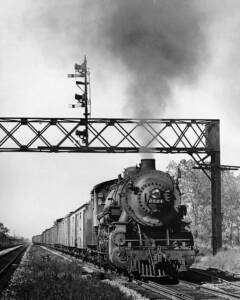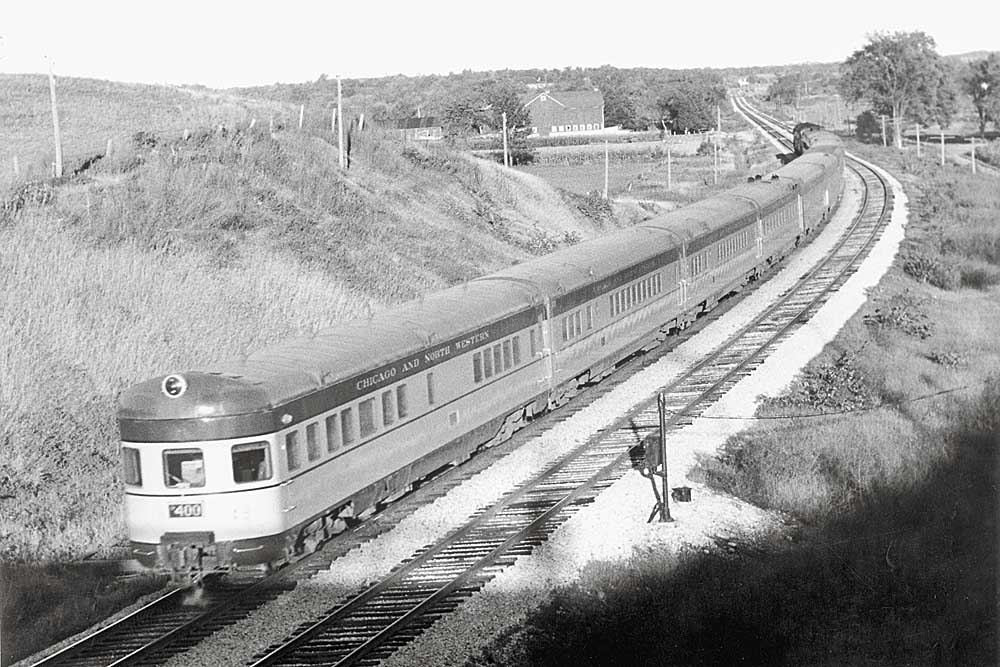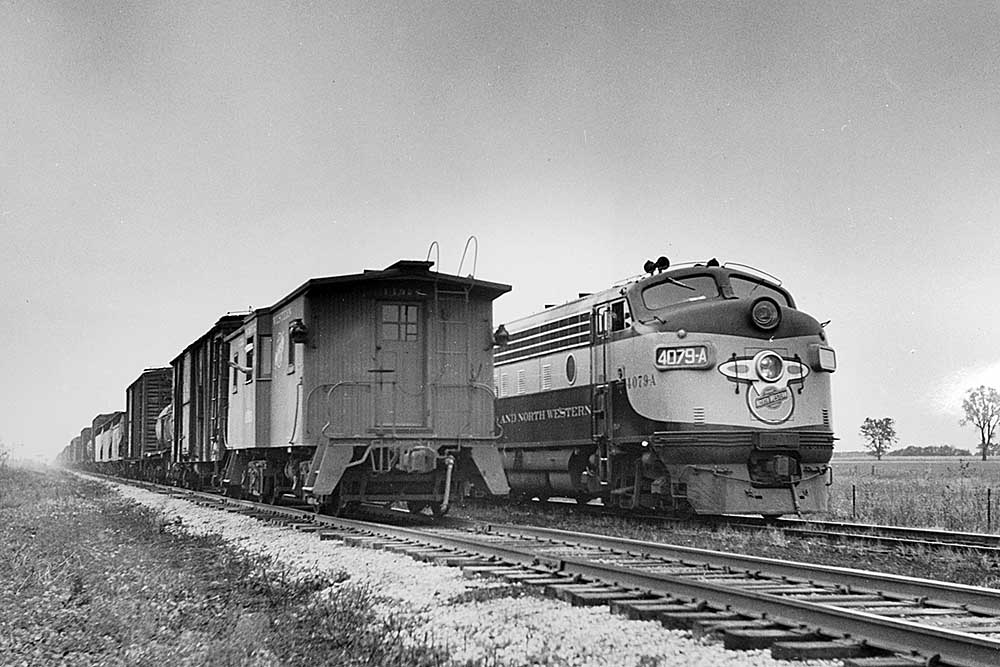For years the Chicago & North Western operated Chicago’s most extensive commuter service. Its three routes were designated West, North, and Northwest. Those names also serve well to group C&NW’s lines west, northwest, and north from Chicago.

West, North, and Northwest
The railroad capital of the U.S., Chicago, saw its first locomotive in 1848: the Pioneer of the Galena & Chicago Union Rail Road. The G&CU, chartered in 1836, lay dormant for 12 years before construction began. By 1850, though, its rails reached west to the Fox River valley at Elgin and in 1853 to Freeport, where it connected with the Illinois Central Railroad.
In 1855 the Galena & Chicago Union completed a second line westward, from what is now West Chicago, reaching Fulton, Illinois, on the Mississippi River. By 1867 the Chicago, Iowa & Nebraska had built from Clinton, Iowa, to Cedar Rapids, and the Cedar Rapids & Missouri River Railroad had extended that line west across Iowa to a connection with the Union Pacific at Council Bluffs, on the east bank of the Missouri River (Chicago & North Western purchased those two companies in 1884).
That line was extended farther west, making a second connection with the Union Pacific at Fremont, Neb., and eventually reached Rapid City, S.D., and Casper, Wyo. A dispute with the Union Pacific caused the North Western to project an extension from Casper over South Pass toward Salt Lake City and Ogden, Utah. By the time the railhead reached Lander, Wyo., the C&NW had come to an agreement with UP and construction stopped.
Railroads were chartered in Illinois and Wisconsin in 1855 to connect Chicago with Milwaukee. The line was completed in 1855, and in 1863 the two companies were consolidated as the Chicago & Milwaukee Railway. The company was leased by the Chicago & North Western in 1866 and was merged in 1883.
Two lines reached north from Milwaukee to Green Bay — one along the shore of Lake Michigan, a continuation of the line from Chicago, and the other northwest through the valley of the Fox River. (There are two Fox Rivers in eastern Wisconsin. One rises near Waukesha and flows south into the Illinois River. The other rises near Portage and flows north and northeast through several lakes into Lake Michigan at Green Bay.) The C&NW developed a dense network of branches in eastern Wisconsin and built lines into the mining area of Michigan’s Upper Peninsula.
About 1906 C&NW constructed a second line from Chicago to Milwaukee for freight trains, a belt line around Milwaukee, and a long main line diagonally across Wisconsin from Milwaukee to a connection with the older Chicago-Twin Cities route at Wyeville.
In 1855 the Chicago, St. Paul & Fond du Lac Rail Road was incorporated to extend an existing road northwest from Cary, Ill., through Madison and La Crosse, Wis., to St. Paul, Minn., and north through Fond du Lac, Wis., to the iron and copper country south of Lake Superior. The company was reorganized in 1859 as the Chicago & North Western Railway. In 1864 the C&NW was consolidated with the Galena & Chicago Union. At that point the C&CU consisted of lines from Chicago to Freeport and to Fulton, Ill., from Belvidere, Ill., to Beloit, Wis., and from Elgin to Richmond, Ill., plus the east-west route across Chicago known as the St. Charles Air Line.

The Omaha Road
Notable among C&NW’s acquisitions was the Chicago, St. Paul, Minneapolis & Omaha Railway. The Omaha Road reached from west-central Wisconsin to the Twin Cities, and from there southwest to Omaha and northeast to Duluth and Superior.
In 1857 the Minnesota legislature passed a bill vesting U. S. government land grants in four railroad corporations. One of them was the Root River & Southern Minnesota Railroad (later simply Southern Minnesota). Work on that line began in 1858, and the company was reorganized in 1862 — still having only roadbed, no rail. In 1864 St. Paul businessmen incorporated the Minnesota Valley Railroad to take over the Southern Minnesota. It was renamed the St. Paul & Sioux City Railroad in 1869.
The Chicago, St. Paul, Minneapolis & Omaha was formed in 1880 by the consolidation of the Northern Wisconsin Railway, which reached north to Bayfield and Superior, Wis., and the Chicago, St. Paul & Minneapolis Railway, which had started out as a railroad chartered to build from Tomah, Wis. to Lake St. Croix. The CStPM&O was headquartered in Hudson, Wis., a few miles east of St. Paul, Minn. It intersected with the Chicago & North Western at 17 points.
C&NW bought a majority of the Omaha Road’s stock in 1882. The CStPM&O operated separately until January 1957 when the C&NW leased the CStPM&O; the North Western officially merged the Omaha Road in 1972.

Chicago & North Western
In 1901 C&NW built a long line south from the Chicago-Council Bluffs line at Nelson, Illinois, through Peoria toward St. Louis. The primary purpose of the line was to carry coal from southern Illinois, but the line also carried Chicago-St. Louis merchandise traffic in cooperation with the Litchfield & Madison Railway, a 44-mile terminal road in the industrial area across the Mississippi River from St. Louis.
The Chicago & North Western was one of a very few railroads in North America whose trains kept to the left on double track. Reasons given for the practice range from a preponderance of British stockholders to (more likely) the position of the station buildings on the lines around Chicago — generally on the left for trains heading toward Chicago. When C&NW double-tracked its lines through the suburbs, it assumed that Chicago-bound passengers would be more likely to use the depot buildings than homeward-bound suburbanites and made the track nearest the station the inbound line.
The North Western became Union Pacific’s preferred connection at Council Bluffs. Until 1955 UP’s yellow streamliners continued to Chicago on the C&NW. In 1955 Union Pacific surprised the railroad industry by switching its trains to the Milwaukee Road for the trip to Chicago. The North Western fell into a decline.
In the 1980s, the North Western once again became UP’s favored connection, partly because C&NW thoroughly rebuilt its line between Chicago and Council Bluffs and partly by default — most of the competing routes had been abandoned.
Latter-day expansion
In the late 1950s and 1960s C&NW merged several smaller railroads: Litchfield & Madison in 1958; Minneapolis & St. Louis in 1960; Chicago Great Western in 1968; and Des Moines & Central Iowa (which owned the Fort Dodge, Des Moines & Southern) in 1968. C&NW gradually dismantled the lines of most of these railroads, keeping only a few strategic segments in service. In 1972 C&NW joined with Missouri Pacific to purchase the Alton & Southern from Alcoa, but a year later sold its half to St. Louis Southwestern.
There was also a change in corporate structure in 1972. The Chicago & North Western Transportation Co. was incorporated in 1970 as the North Western Employees Transportation Co., owned by nearly 1,000 C&NW employees. In 1972 it purchased the transportation assets of the Chicago & North Western Railway and changed its name to Chicago & North Western Transportation Co. For some time thereafter the road’s herald carried the words “Employee Owned.” In 1989 Chicago & North Western Holdings Corp., which owns the transportation company, was formed by Blackstone Capital Partners. It was privately held until 1992.
After the 1980 demise of the Rock Island the C&NW acquired Rock’s Minneapolis-Kansas City “spine line,” and by the mid-1980s abandoned the somewhat longer Chicago Great Western route between those cities.
The North Western’s other major expansion was into the Powder River Basin of northeastern Wyoming. C&NW (through a subsidiary, Western Railroad Properties) and Burlington Northern jointly operated a line north into the coalfields from Orin and Shawnee, Wyoming (the line was constructed by BN between 1976 and 1979). In 1984 C&NW opened a new line along the Wyoming-Nebraska state line to a connection with Union Pacific’s line along the North Platte River rather than rebuild more than 500 miles of its line across northern Nebraska.
Contraction and merger
The North Western spun off two major groups of lines to form regional railroads:
- Dakota, Minnesota & Eastern Railroad: Winona, Minn., to Rapid City,
S. D., plus branches, 965 miles in all (September 1986)
- Fox River Valley Railroad: two lines from Green Bay to Granville and Cleveland, Wis., plus branches, 214 miles (December 1988). Sale of the two main lines south of Green Bay had the effect of isolating C&NW’s lines in northern Wisconsin and Michigan’s Upper Peninsula from the rest of the system. Wisconsin Central later purchased those lines as well as the Fox River Valley Railroad.
By the 1990s most of Chicago & North Western’s traffic was concentrated on two lines: Chicago to Council Bluffs, essentially an eastern extension of Union Pacific’s transcontinental main line, and the Wyoming and Nebraska coal lines.
During the late 1980s the C&NW was the target of several hostile takeover attempts. Union Pacific was concerned about these — by then C&NW was its principal eastern connection. On March 17, 1995, Union Pacific announced its intention to buy the 70% of the C&NW that it did not already own.














Nice history, I would love if for each addition to the railroad described, a small map would show the whole system and the new segment in an alternate color.
The last time I rode the C&NW was in 1967 from my hometown, Racine, Wisconsin, to Oshkosh, Wisconsin to visit a friend and play golf and tennis. What a great ride.
Actually, the UP wanted to buy the Rock Island and filed with the ICC to do so. It took 4 years to obtain approval and, during those 4 years, the Rock had crumbled. Though it was the shortest route between Council Bluffs and Chicago, the property and motive power had deteriorated terribly due to lack of funds. Much of the mainline was restricted to 10 MPH. The cost to overhaul the track and totally replace/overhaul the run down motive power made it financially impractical to purchase. UP’s only other choice was the C&NW.
Kenneth Olsen